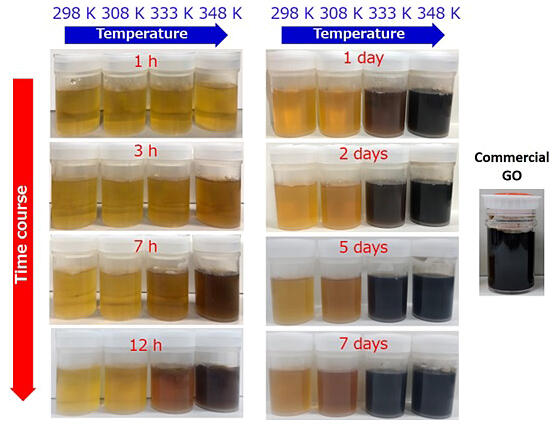A research group led by Professor Katsumi Kaneko and Assistant Professor Hayato Otsuka at the Shinshu University Research Initiative for Supra-Materials announced the development of a method to easily determine the state of unstable graphene oxide (GO) through its optical absorption spectrum. The method is expected to be able to determine GO electrical conductivity, magnetism, and structure from optical absorption spectral positions and enable the selection and use of GO with the most suitable properties for different applications. The results were published in the International Academic Journal Nature Communications on February 24.

Provided by Shinshu University
While graphene, which is obtained by reducing GO, is a material used in many advanced industries such as energy storage and electronic devices, the fact that GO changes over time has been an issue. GO is obtained by oxidizing graphite as colloidal particles dispersed in an aqueous solution. Graphite is shiny black, but the color of the GO colloidal solution is light ochre immediately after preparation and gradually darkens over time as it ripens. In general, the rate of chemical change increases with increasing temperature, and if the changes at room temperatures of 25℃ and 75℃ are examined, a long term change at 25℃ is captured in a short time at 75℃.
The research group measured the optical absorption spectra of GO aged for different durations (0−168 h) to quantify this color change. The strongest absorption spectrum revealed information about the framework structure derived from the two-dimensional chemical bonding state of GO, and the position of the peaks indicated that the structure hardly changed at 25℃. Meanwhile, at 75℃, the peak position and shape changed. The researchers corrected for this apparent difference by assuming that the structure changes in a consistent manner independent of temperature.
They also introduced a conversion time obtained by dividing the real time by the time it takes to reach a common peak position regardless of temperature. The results showed that the experimental data at different temperatures were largely aligned along the same curve, indicating that the GO structure changes consistently independent of temperature. An analysis of GO state changes revealed that there are three states: initial-stage graphene oxide (true graphene oxide; iGO), metastable graphene oxide (mGO), and transient graphene oxide (tGO), which in turn changes to the reduced form. In addition to the optical absorption spectra, properties such as magnetism and electrical resistance were also found to differ among iGO, mGO, and tGO.
Kaneko said, "Many research papers on GO have been published around the world, but information on which state of unstable GO exists has not been described yet. If researchers and engineers could clearly indicate which state of GO they are targeting using the proposed optical absorption spectroscopy method, this would promote its application and lead to improvements in technologies."
Journal Information
Publication: Nature Communications
Title: Transient chemical and structural changes in graphene oxide during ripening
DOI: 10.1038/s41467-024-46083-4
This article has been translated by JST with permission from The Science News Ltd. (https://sci-news.co.jp/). Unauthorized reproduction of the article and photographs is prohibited.




